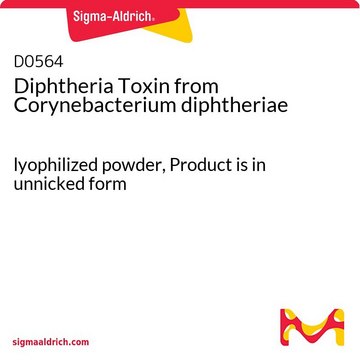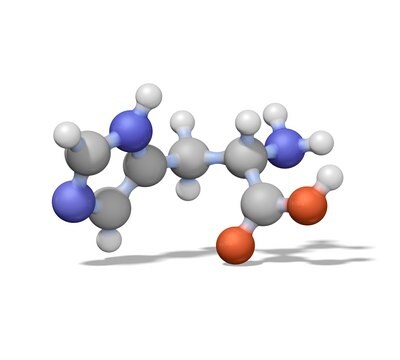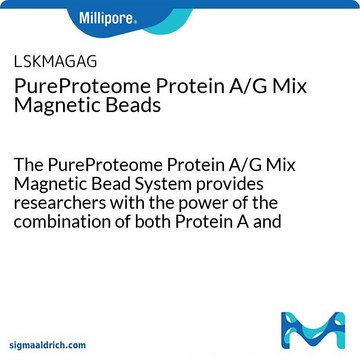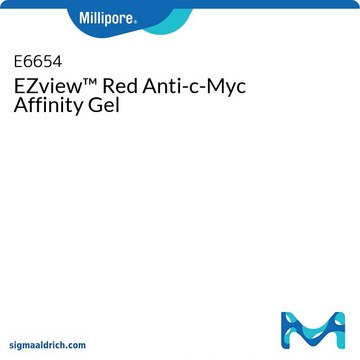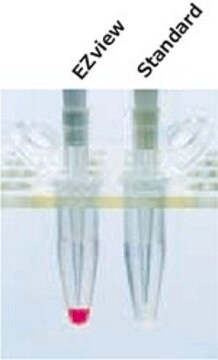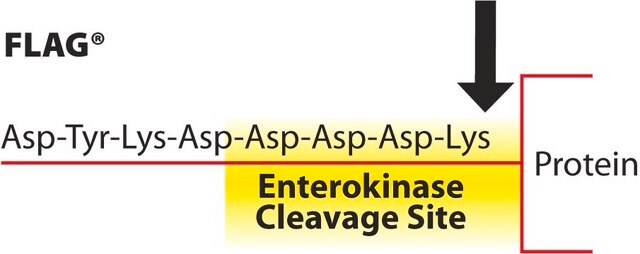E3403
EZview™ Red Protein G Affinity Gel
Sinónimos:
EZview Affinity Gel, Protein G Affinity Gel
Iniciar sesiónpara Ver la Fijación de precios por contrato y de la organización
About This Item
Productos recomendados
Formulario
liquid
Nivel de calidad
clases químicas de analitos
proteins (Immunoglobulins of various mammalian species)
técnicas
affinity chromatography: suitable
immunoprecipitation (IP): suitable
capacidad
≥8 mg/mL, gel binding capacity (rabbit IgG)
temp. de almacenamiento
−20°C
Categorías relacionadas
Descripción general
EZ view Red Protein G Affinity Gel is Protein G covalently bonded to 4% Agarose beads. The affinity gel is used to bind the FC portion of the IgG of an antibody to samples, such as cell lysates and tissue, for purification of proteins in preparation of immunoprecipitation assays. Red dye enhances visability for more efficient results.
Aplicación
When performing small-scale affinity capture, such as immunoprecipitation, the affinity matrix is difficult to see in the microcentrifuge tubes. Accidental aspiration of the resin leads to quantitative variability in results. The EZview™ Red Affinity Gels greatly reduce the risk of pellet loss. EZview resins perform as well as conventional non-colored affinity gels, but allow the user to easily differentiate pellet from supernatant. This correlates to more accurate data because less protein is lost.
Características y beneficios
- Increased visibility - Red color reduces risk of incidental aspiration
- Improved recovery of target protein by reduced accidental loss
- Higher reproducibility - More consistent yields
Forma física
1:1 (v/v) suspension in PBS containing 50% glycerol and 15 ppm Kathon
50% slurry in PBS with 50%Glycerol and 0.0015%
Información legal
EZview is a trademark of Sigma-Aldrich Co. LLC
Código de clase de almacenamiento
10 - Combustible liquids
Clase de riesgo para el agua (WGK)
WGK 3
Punto de inflamabilidad (°F)
Not applicable
Punto de inflamabilidad (°C)
Not applicable
Elija entre una de las versiones más recientes:
¿Ya tiene este producto?
Encuentre la documentación para los productos que ha comprado recientemente en la Biblioteca de documentos.
Los clientes también vieron
Min Mo et al.
Proceedings of the National Academy of Sciences of the United States of America, 106(46), 19527-19532 (2009-11-06)
The anaphase-promoting complex (APC), or cyclosome, is a ubiquitin ligase with major roles in cell cycle regulation. It is required for mitotic exit, but must be deactivated for the G(1)/S phase transition to occur. APC consists of at least 12
Yuval Malka et al.
Nature communications, 8(1), 2029-2029 (2017-12-13)
The majority of mammalian genes contain one or more alternative polyadenylation sites. Choice of polyadenylation sites was suggested as one of the underlying mechanisms for generating longer/shorter transcript isoforms. Here, we demonstrate that mature mRNA transcripts can undergo additional cleavage and
Alvaro Quintanal-Villalonga et al.
Lung cancer (Amsterdam, Netherlands), 131, 112-121 (2019-04-28)
Lung adenocarcinoma accounts for approximately half of lung cancer cases. Twenty to 50% of tumors of this type harbor mutations affecting epidermal growth factor receptor (EGFR) expression or activity, which can be therapeutically targeted. EGFR inhibitors in this context exhibit
Álvaro Quintanal-Villalonga et al.
EBioMedicine, 53, 102683-102683 (2020-03-03)
Fibroblast growth factor receptor (FGFR)1 and FGFR4 have been associated with tumorigenesis in a variety of tumour types. As a therapeutic approach, their inhibition has been attempted in different types of malignancies, including lung cancer, and was initially focused on
Juri Kazakevych et al.
Nucleic acids research, 45(10), 5770-5784 (2017-03-24)
Epigenetic mechanisms, including chromatin structure, chromatin dynamics and histone modifications play an important role for maintenance and differentiation of pluripotent embryonic stem cells. However, little is known about the molecular mechanisms of adult stem cell specification and differentiation. Here, we
Nuestro equipo de científicos tiene experiencia en todas las áreas de investigación: Ciencias de la vida, Ciencia de los materiales, Síntesis química, Cromatografía, Analítica y muchas otras.
Póngase en contacto con el Servicio técnico